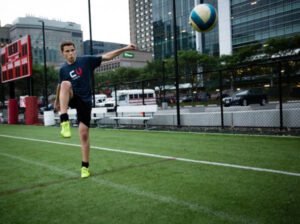Have you ever finished a marathon and thought to yourself: “I wish that were longer”? If you’re like most people, the thought of running a 26.2 mile marathon is enough to make you tired. However, there exists a select group of people who have answered that question in the affirmative – and some of them have done something about it. Introducing…the ultramarathon. An ultramarathon refers to any race that is longer than the traditional marathon distance, but some typical race distances are: 50km, 100km, 50 miles, and even 100 miles! Other classic events include 24-hour races and double marathons, which are exactly as long and brutal as they sound. Approximately 70,000 tough souls complete ultramarathons annually and more people are signing up every year.
Given the distances, most people would hope for an easy, flat course… but not ultramarathoners! In fact, some of the most popular ultramarathons became so popular precisely because of their extremely difficult weather and terrain. One of the most well-known ultramarathon courses, the Badwater Ultramarathon in California holds the undisputed title for most difficult course. Located in the heart of Eastern California’s sweltering hot Death Valley and spanning 135 miles of desert, Badwater is a formidable challenge for even seasoned ultramarathoners.
Although the ultramarathoning craze took off in the 1970s, the first ultramarathons can be traced back to the mid 1800s when a man named Edward Payson captivated the attention of the nation by walking from Portland, Oregon to Chicago, Illinois in 25 days. Soon other long distance races began sprouting up all over the country and attracting thousands of spectators and substantial sums of prize money for winners. After the advent of the automobile, public interest dropped off substantially, but interest resurfaced in the second half of the 20th century.
If you are the type of person who yearns for new challenges, maybe ultramarathoning is exactly what you’ve been looking for. Here are some quick tips for those new to the sport:
- Food and Water: Unlike shorter distance runners, ultramarathoners must bring ample food and water with them on their races. Over 100 miles, you will inevitably get hungry and thirsty. Most courses have stops periodically along the course for restocking food, water and medical supplies. However, it’s important to be able to carry enough with you between stops.
- Gear: Over ultramarathon distances, even the slightest discomfort in clothing or shoes can be a road to disaster. Make sure to get gear and apparel that fits you best. Do training runs in your racing outfit to adapt to how it feels.
- Don’t Rush: Start your running training many months in advance of your first race. Remember, nobody can finish an ultramarathon using determination alone. Hard, systematic training is essential.
CoachUp is the safest and easiest way to find a coach for personalized training. With our 100% money-back guarantee and vetted coaches, anyone can achieve their full athletic potential. Find your perfect coach today and become the athlete you want to be!
How useful was this post?
Click on a star to rate it!
Average rating 0 / 5. Vote count: 0
No votes so far! Be the first to rate this post.



